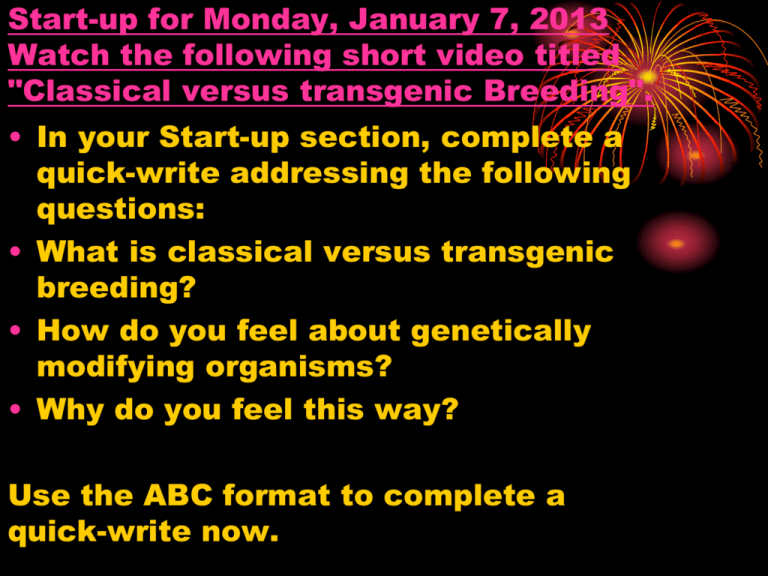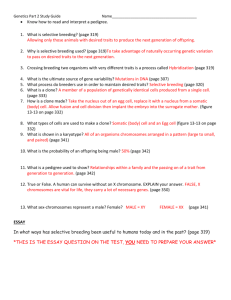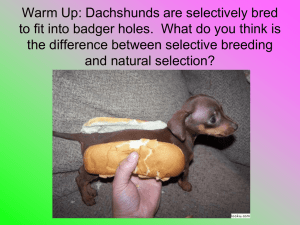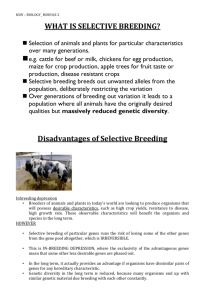File
advertisement

Start-up for Monday, January 7, 2013 Watch the following short video titled "Classical versus transgenic Breeding". • In your Start-up section, complete a quick-write addressing the following questions: • What is classical versus transgenic breeding? • How do you feel about genetically modifying organisms? • Why do you feel this way? Use the ABC format to complete a quick-write now. Start-up for Wednesday, January 9, 2013 Create as many words as you can at least three letters long off of the following: GENETIC ENGINEERING Biology – Chapter 13 Section 1, Page 319-321 • Objectives: Students will • A. Define selective breeding and compare the two types. • B. Identify at least three purposes of selective breeding. • C. Identify two ways that genetic variation is increased. • D. Define genetic engineering and transgenic organisms. • A. Define selective breeding and compare the two types. What do you think selective breeding is? Artificial Selection = Selective Breeding We do it with our plants. We do it with our animals. We do it with ourselves. Humans choose how organisms breed Look at the differences between the following species of dog: • A. Define selective breeding and compare the two types. Wild dogs Terriers From where did they come? Viemerana Collies • A. Define selective breeding and compare the two types. Over thousands of years man has selected characteristics in dogs that are useful….. •Very small dogs •Used for pets •Large hunting dogs •Strong & powerful •Large working dogs •Strong and athletic This is SELECTIVE BREEDING • A. Define selective breeding and compare the two types. Selective Breeding: Inbreeding vs. Hybridization + •Very small dogs •Used for pets •Large hunting dogs •Strong & powerful •Medium dogs = •Friendly •Strong & powerful •Large = working dogs + Which mating is inbreeding and why? •Strong and athletic •Large working dogs Why is inbreeding potentially bad? •Strong and athletic • A. Define selective breeding and compare the two types. Identify each of the following types of selective breeding: • 1. Tall x short pea plants• • 2. Dautson x Dautson • Dogs • 3. Yorkshire x Hampshire• Pigs • 4. Suffolk x Suffolk Lambs • • 5. Roma x Roma • Tomatoes • 6. Mexican x Chinese • Human 1. Hybridization 2. Inbreeding 3. Hybridization 4. Inbreeding 5. Inbreeding 6. Hybridization B. Identify at least three purposes of selective breeding. Why is selective breeding a good thing when it comes to plants and animals? Artificial selection (selective breeding) = Breed improvement of animals and plants, for man’s benefit. 1) More milk = More food 2) Structural correctness = lives longer B. Identify at least three purposes of selective breeding. This artificial selection of characteristics happens in plants as well.. In the wild there are various species of corn plant B. Identify at least three purposes of selective breeding. Good point: Strong stem 1 Bad point: Small root 2 Bad point: Small head Good point: strong roots Good point: Huge head of grain Bad point: Small plant 3 Bad point: Drought sensitive 4 Good point: Disease resistant B. Identify at least three purposes of selective breeding. Good point: Good point: Good point: Good point: Strong stem Disease resistant Huge head of grain Strong roots Super CORN! Longer shelf life Disease resistance More Food Heat, wind and drought tolerance B. Identify at least three purposes of selective breeding. Look what has happened to the varieties of the corn over last few hundred years. B. Identify at least three purposes of selective breeding. Look at the variety of plants that have been artificially selected from mustard! C. Identify two ways that genetic variation is increased. How do scientists increase variation? C. Identify two ways that genetic variation is increased. Polyploidy = many sets of chromosomes Induced in plants, not animals Increases production Growing lots of different varieties of wheat………… ……looking for new characteristics. Things I must know about artificial selection/selective breeding •A.S. is the gradual improvement of organisms characteristics – for humans benefit. •A.S. takes hundreds of years •We have A.S. lots of animals and plants •A.S. animals & plants produce higher yields: 1. more milk 2. more meat 3. more fruit D. Define genetic engineering and transgenic organisms. What do engineers do to buildings? Based on this, what do you think genetic engineering is? It’s the changing of DNA on purpose Why? Cures Specie Improvement Scientific curiosity D. Define genetic engineering and transgenic organisms. What is created? Transgenic organisms. What does the pre-fix trans mean? Trans – across or opposite sides Transgenic organisms contain genes from different organisms. “Across” different species. Examples: How is it done? Transformation: Inserting genes from a different organism using a plasmid (circular bacteria) Exit Ticket • 1. Choosing how organisms mate is called what? • 2. If you breed a holstein (black and white) to a jersey cow (brown), what type of selection is this? • 3. How do scientists increase genetic variation? • 4. How are selective breeding and genetic engineering different? • 5. How are selective breeding and genetic engineering the same? Show me these completed and complete your link word. It is due today. Assignment 2/5/14 Finish : 1. Exit ticket (Turn in as you leave today) 2. Link words (Due Today) 3. Pg. 321 #1-5 and turn in







